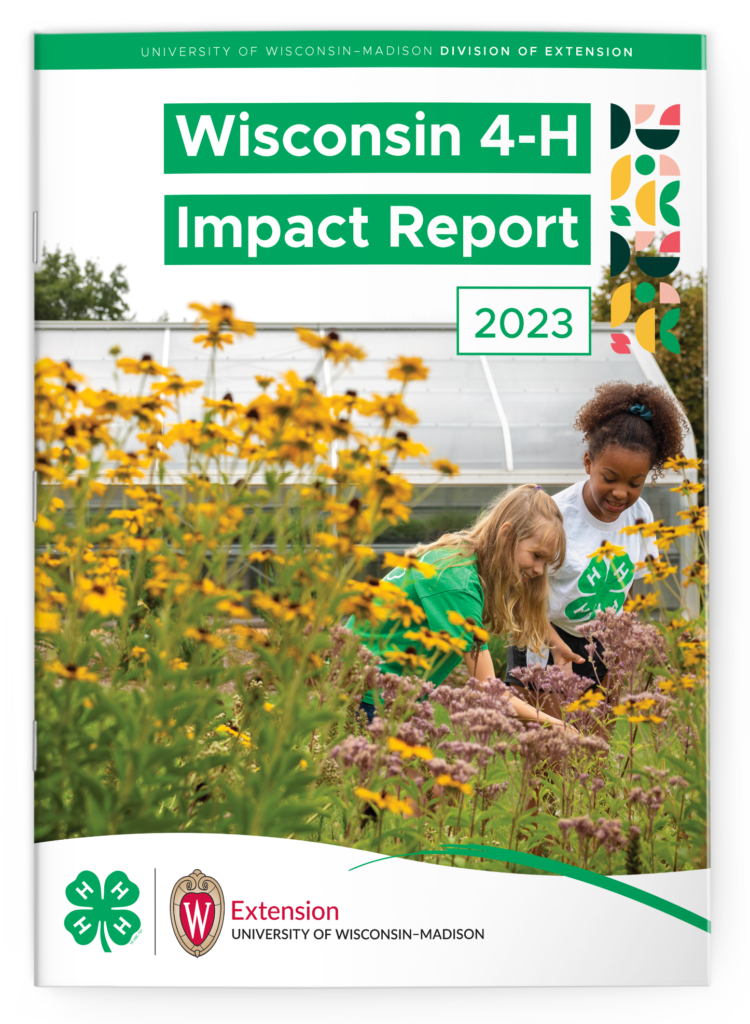About
4-H is the nation’s largest youth development and empowerment organization. In Wisconsin, more than 26,000 youth are members of 4-H. The 4-H programming aims to engage youth in activities to increase their leadership, communication, and critical thinking skills. Our programs center on the 4-Hs—head, heart, hands, and health. This is the foundation for everything we do.
Wisconsin 4-H has over 5,600 volunteers who serve as mentors for 4-H youth. They help provide a safe, engaging place for youth to take risks, practice their independence and master new skills. Research shows there are many benefits to being involved in 4-H. 4-H youth are:

Wisconsin 4-H Impact Report

Learn more about 4-H
History
Since 4‑H began more than 100 years ago, it has become the nation’s largest youth development organization. The 4‑H idea is simple: help young people and their families gain the skills needed to be proactive forces in their communities and develop ideas for a more innovative economy.
The Birth of 4‑H Programs
4‑H opened the door for young people to learn leadership skills and revolutionized how youth connected to practical, hands-on learning experiences outside the classroom.
Late 1800’s: Making Connections
In the late 1800’s, researchers discovered adults in the farming community did not readily accept new agricultural developments on university campuses, but found that young people were open to new thinking and would experiment with new ideas and share their experiences with adults. In this way, rural youth programs introduced new agriculture technology to communities. The idea of practical and “hands-on” learning came from the desire to connect public school education to country life. Building community clubs to help solve agricultural challenges was a first step toward youth learning more about the industries in their community.
1902: Youth Clubs are Formed
A. B. Graham started a youth program in Clark County, Ohio, in 1902, which is considered the birth of 4‑H in the United States. The first club was called “The Tomato Club” or the “Corn Growing Club”. T.A. Erickson of Douglas County, Minnesota, started local agricultural after-school clubs and fairs that same year. Jessie Field Shambaugh developed the clover pin with an H on each leaf in 1910, and by 1912 they were called 4‑H clubs.
1914: Cooperative Extension System is Created
The passage of the Smith-Lever Act in 1914 created the Cooperative Extension System at USDA and nationalized 4‑H. By 1924, 4‑H clubs were formed and the clover emblem was adopted.
The Cooperative Extension System is a partnership of the National Institute of Food and Agriculture (NIFA) within the U.S. Department of Agriculture (USDA), more than 100 land-grant universities and more than 3,000 county offices across the nation. Cooperative Extension combines the expertise and resources of federal, state, and local governments and is designed to meet the need for research, knowledge and educational programs.
4‑H Today
Today, 4‑H serves youth in rural, urban, and suburban communities in every state across the nation. 4‑H’ers are tackling the nation’s top issues, from global food security, climate change and sustainable energy to childhood obesity and food safety. 4‑H out-of-school programming, in-school enrichment programs, clubs and camps also offer a wide variety of STEM opportunities – from agricultural and animal sciences to rocketry, robotics, environmental protection and computer science – to improve the nation’s ability to compete in key scientific fields and take on the leading challenges of the 21st century.
– From National 4-H Council website





